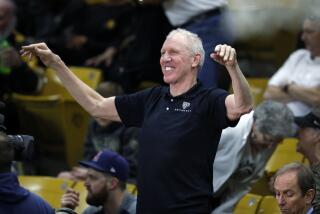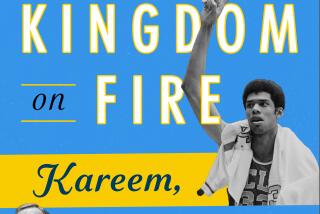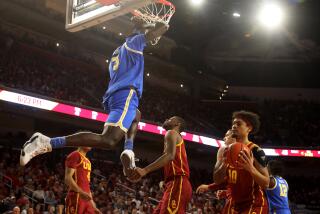BOWLS 85-86 : ORANGE : OPPOSITES DO ATTRACT : Paterno and Switzer Have Different Styles but Similar Success
MIAMI, Fla. — If an honest biography were written about Barry Switzer, Oklahoma’s football coach, it no doubt would include tales about his late father, an Arkansas bootlegger; details of Switzer’s divorce, scandalous tidbits about his personal life, his trouble with the Feds over a stock deal and the circumstances that almost caused him to be run out of Norman, Okla., by Sooner fans, the media and the board of regents.
For the title, the nickname that has been given to him by other coaches could be used. Call it “Bad Barry.”
Penn State Coach Joe Paterno’s biography already has been written. In “Football My Way,” Paterno talks about his background as an English literature major at Brown, quotes from Robert Browning and advocates the Grand Experiment, which Paterno says proves that the words student and athlete aren’t mutually exclusive. With an initial contribution of $20,000, he established a library endowment fund at Penn State.
If Gandhi returned to earth as a football coach, he would be Joe Paterno.
The presence of Switzer and Paterno on the sidelines Wednesday night in the Orange Bowl represents not only a clash between two of the most successful football coaches, but also a clash of styles, both personal and professional. That was clearly evident during a 24-hour period here late last week.
Five days before Oklahoma was to play Penn State in a game that will have a bearing on the national championship, the Sooners were entering the final stages of one of their helter-skelter Friday afternoon workouts. This one was being conducted by the assistant coaches because Switzer had not yet made an appearance.
“The team practices without Switzer?” a man said to a University of Oklahoma spokesman.
He shrugged. “It’s been known to happen,” he said.
A few minutes later, as the team was beginning its final drill of the afternoon, Switzer arrived.
Later, reporters asked him for an assessment of the workout.
“The last three minutes were damn good,” he said, laughing.
When the Sooners arrived in Miami, they were wearing T-shirts and warmup suits. They were greeted by Goofy, Mickey Mouse and the Orange Bowl queen. While the Oklahoma players gave interviews, Switzer and Goofy exchanged greetings.
When the Penn State players landed, they were dressed in suits and ties. Goofy wasn’t at the airport to greet them because of a scheduling conflict, but it’s doubtful Paterno would have said anything to him, to Mickey Mouse or even the Orange Bowl queen. He didn’t talk to anyone else. He and his players got on a bus and rode to the Orange Bowl, where they had a 2-hour, 15-minute workout.
“Paterno rains on his own Miami parade,” was the headline in the Miami News the next day.
A Miami Herald headline on the same day called the Nittany Lions “Businesslike.”
Paterno wouldn’t quibble with that description. Penn State’s offense is businesslike, controlling the clock, seldom turning the ball over, passing only when necessary, plodding to one victory after another. Penn State’s uniforms are businesslike, blue and white with block letters and no names on the backs.
“Chuck Fusina (former Penn State quarterback) once said that if Coach Paterno could get away with it, he’d remove the numbers from our uniforms,” Lion quarterback John Shaffer said. “Guys with black-and-white television sets must love us.”
Paterno calls the uniforms traditional. The Sooners call them old-fashioned.
The Sooners run a high-risk, high-excitement wishbone offense that features about a dozen running backs who run the 40 in 4.4 or faster. They wear flamboyant red-and-white uniforms. For this game, they have Orange Bowl patches on their sleeves.
The Nittany Lions voted not to wear the orange patches in order to maintain the dignity of their uniforms.
“That made me proud,” Paterno said.
But the differences in these two teams are more than uniform deep. The teams are staying in the same hotel, the Fontainebleau Hilton on Miami Beach, which has given them an opportunity to get a good look at each other.
“They’re just like we are,” Penn State defensive back Lance Hamilton said.
The Sooners beg to differ. They are somewhat amused by the Nittany Lions’ serious attitudes, looking at them through the same eyes as the mischievous members of Delta house looked at the more straight-laced members of a rival fraternity in the movie “Animal House.” It would be difficult to imagine the Nittany Lions becoming involved in a food fight, but not the Sooners.
“The difference between us and Penn State is that we’re so relaxed,” Oklahoma freshman quarterback Jamelle Holieway said. “We’re just being our natural selves. They’re so intense . I don’t think that’s their natural selves.”
He paused. “Maybe it is,” he said.
As he conducted the interview, Holieway was reclining on the field at the Orange Bowl, propping himself up on his elbow, while a group of reporters stood over him. Holieway, from Banning High School, was wearing sunglasses, a gold earring and a gold bracelet, apparently standard items in the Sooners’ uniforms.
A reporter asked him about the contents of his purse, an Yves St. Laurent designer model.
Holieway unzipped the purse and pulled out a matching Yves St. Laurent wallet, cassette tapes for his Walkman, his hotel key and a gold ring.
Another reporter asked him about the tattoo on his left arm. It reads “Jammin’,” which is his nickname.
When a reporter noted that Holieway seemed remarkably composed, considering the task ahead of him Wednesday night, Holieway said: “I’m just doin’ like I always do. If I looked at this as a special game, I’d be freakin’ out.”
On another part of the field, Oklahoma linebacker Brian Bosworth stood in a crowd of reporters and talked about his haircut, which is shaggy and blond on top, short and brown on the sides and has a shoulder-length tail. It was all red until last Friday.
“Peroxide?” a reporter asked.
“Nah,” Bosworth said. “I had it colored.”
Bosworth, known as the Wizard of Boz, is the spiritual leader of a defense whose members bark like dogs in the dressing room before games to relieve tension.
Contrast the outspoken Boz to the most outspoken of the Nittany Lions, Hamilton, who is a pre-law student and a two-time Academic All-American.
He began participating in civil rights marches with his family when he was 4, has the fingernail on the little finger of his left hand painted green in memory of the children murdered in Atlanta, and hopes to continue his father’s work in the Hands-of-Hope ministry program, a 24-hour, nonprofit operation in Wilkes-Barre, Pa., that feeds the hungry, shelters the homeless and counsels the disturbed.
On the surface, it would appear that the differences in the teams are reflections of the differences in the coaches.
Switzer has an outlaw image.
“I don’t mind wearing the black hat if I have to,” he said last week.
Paterno has no aversion to being pictured in a white hat.
But on second glance, the line that can be drawn between the two men is not so distinct, not so black and white.
Paterno tried to make it appear so six years ago when, in a flippant remark, he said he wouldn’t consider retiring because that would “turn over college football to the Barry Switzers and Jackie Sherrills.” Sherrill, coach at the time at Penn State’s intrastate rival, Pittsburgh, now is the coach at Texas A&M.;
Paterno since has apologized for the comment, saying that he made it before he knew Switzer. While he and Sherrill remain at odds, Paterno and Switzer have become friends.
Paterno said that he has a better understanding now of the pressures on Switzer.
“I don’t think we have the same kind of alumni pressure in our area that there is in the Southwest,” he said. “Our board of regents at Penn State doesn’t have much to say about the football team. It’s just a little bit easier to coach in our area than it is in that area.”
Switzer said that his reputation is such that most people don’t like him until they get to know him.
Of Paterno’s six-year-old remark, Switzer also said, “At that time, he may have been right.”
Friends of the 48-year-old Switzer say he has matured in recent years. They say that while he once lived a fast-lane life style, he has been considerably less active since his divorce a few years ago and remains a devoted father to his three teen-age children, who live in Little Rock with their mother.
They say he pays more attention to his football team and less to his business investments, particularly since the Securities and Exchange Commission charged him with obtaining illegal inside information on a stock deal. Switzer won in court.
When he wasn’t fighting the SEC, it was the NCAA. His reputation nationally was of a coach who played fast and loose with the rules, even though there rarely was evidence to support it. He apparently also has put that behind him. Even though he recruits in the same areas as do the Southwest Conference teams that are currently under investigation by the NCAA, the Sooners, so far, have remained above suspicion.
His friends also say that while he once was considered arrogant, not surprising considering that he didn’t lose in his first 28 games and won national championships in his second and third seasons as head coach, he was humbled by four-loss seasons in 1981, ’82 and ’83.
In an area once known as Switzer-land, fan support was rapidly dwindling after the 8-4 season in 1983. Oklahoma’s most influential newspaper, the Daily Oklahoman, called for Switzer’s ouster in a scathing editorial. The board of regents was behind him, but only conditionally. A university whose former president once said: “We want a university that the football team can be proud of,” no longer was proud of Switzer.
One person close to the university, who asked not to be named, said that the regents, in effect, told Switzer “they could put up with him as long as he was winning championships, but that if the team was going to lose 12 games in three years he had better clean up his act.”
The regents specified that there had to be improvement in the graduation rate of the university’s football players, regularly among the nation’s lowest.
In response to that and also to the NCAA’s stricter academic requirements for incoming freshmen, Switzer began recruiting better students and increased the academic counseling staff from one full-time member to three.
Oklahoma’s graduation rate still hasn’t approached that of Penn State, one of three Division I universities in the nation last year that graduated more than 75% of its football seniors. Virginia and Notre Dame were the others.
But university spokesman Mike Treps said that the Sooners have improved their graduation rate to more than 50% of the players who originally enrolled at Oklahoma as freshmen, and that every senior on the team who doesn’t have eligibility remaining will graduate next spring.
One of the pictures in Oklahoma’s recruiting brochure shows Billy Sims, former Heisman Trophy winner, walking across the stage in cap and gown to receive his diploma two years after he had completed his college eligibility. It’s the type of picture that might be found in Penn State’s recruiting brochure. Perhaps the twain in college football shall meet, after all.
More to Read
Go beyond the scoreboard
Get the latest on L.A.'s teams in the daily Sports Report newsletter.
You may occasionally receive promotional content from the Los Angeles Times.










